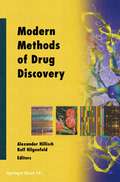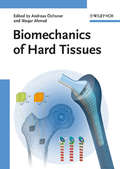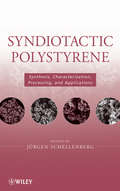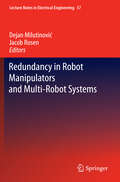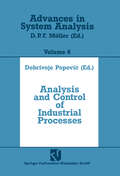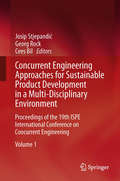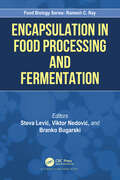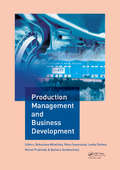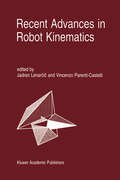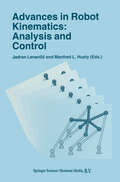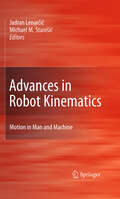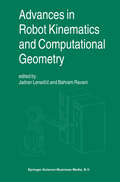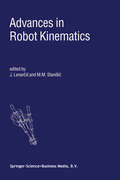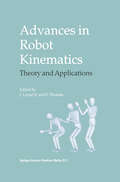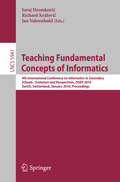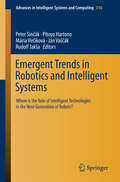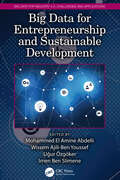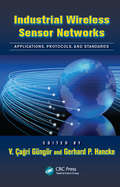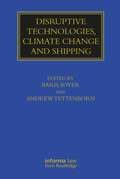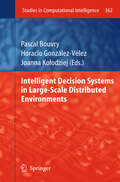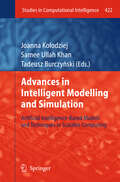- Table View
- List View
Geospatial Analysis with SQL: A hands-on guide to performing geospatial analysis by unlocking the syntax of spatial SQL
by Bonny PLeverage the power of SQL to perform geospatial analysis and increase your speed and efficiency working with a variety of spatial applications such as PostGIS and QGISKey FeaturesFollow along with actionable instructions with this practical guideBecome well-versed in advanced spatial modeling and machine learning techniquesLearn best practices for performing spatial analysis from an expert spatial data analystBook DescriptionGeospatial analysis is industry agnostic and a powerful tool for answering location questions. Combined with the power of SQL, developers and analysts worldwide rely on database integration to solve real-world spatial problems. This book introduces skills to help you detect and quantify patterns in datasets through data exploration, visualization, data engineering, and the application of analysis and spatial techniques. You will begin by exploring the fundamentals of geospatial analysis where you’ll learn about the importance of geospatial analysis and how location information enhances data exploration. Walter Tobler’s second law of geography states, “the phenomenon external to a geographic area of interest affects what goes on inside.” This quote will be the framework of the geospatial questions we will explore. You’ll then observe the framework of geospatial analysis using SQL while learning to create spatial databases and SQL queries and functions. By the end of this book, you will have an expanded toolbox of analytic skills such as PostGIS and QGIS to explore data questions and analysis of spatial information.What you will learnUnderstand geospatial fundamentals as a basis for learning spatial SQLGenerate point, line, and polygon data with SQLUse spatial data types to abstract and encapsulate spatial structuresWork with open source GIS combined with plug-insVisualize spatial data and expand QGIS functionality with PostgresApply location data to leverage spatial analyticsPerform single-layer and multiple-layer spatial analysesWho this book is forThis book is for anyone looking to leverage their SQL knowledge to perform geospatial analysis. GIS analysts, data analysts, and data scientists with a basic understanding of both geospatial analysis and SQL will find this book useful.
Modern Methods of Drug Discovery (Experientia Supplementum #93)
by Dr Prof.Research in the pharmaceutical industry today is in many respects quite different from what it used to be only fifteen years ago. There have been dramatic changes in approaches for identifying new chemical entities with a desired biological activity. While chemical modification of existing leads was the most important approach in the 1970s and 1980s, high-throughput screening and structure-based design are now major players among a multitude of methods used in drug discov ery. Quite often, companies favor one of these relatively new approaches over the other, e.g., screening over rational design, or vice versa, but we believe that an intelligent and concerted use of several or all methods currently available to drug discovery will be more successful in the medium term. What has changed most significantly in the past few years is the time available for identifying new chemical entities. Because of the high costs of drug discovery projects, pressure for maximum success in the shortest possible time is higher than ever. In addition, the multidisciplinary character of the field is much more pronounced today than it used to be. As a consequence, researchers and project managers in the pharmaceutical industry should have a solid knowledge of the more important methods available to drug discovery, because it is the rapidly and intelligently combined use of these which will determine the success or failure of preclinical projects.
100% Unofficial Roblox Mega Hits 3
by 100% UnofficialOVER 15 MORE OF ROBLOX’S BEST GAMES INSIDE FOR YOU TO EXPLORE
Biomechanics of Hard Tissues: Modeling, Testing, and Materials
by Andreas 214 Chsner Waqar AhmedThis monograph assembles expert knowledge on the latest biomechanical modeling and testing of hard tissues, coupled with a concise introduction to the structural and physical properties of bone and cartilage. A strong focus lies on the current advances in understanding bone structure and function from a materials science perspective, providing practical knowledge on how to model, simulate and predict the mechanical behavior of bone. The book presents directly applicable methods for designing and testing the performance of artificial bones and joint replacements, while addressing innovative and safe approaches to stimulated bone regeneration essential for clinical researchers.
Syndiotactic Polystyrene: Synthesis, Characterization, Processing, and Applications
by J 252 Rgen SchellenbergSyndiotactic Polystyrene (SPS), synthesized in a laboratory for the first time in 1985, has become commercialized in a very short time, with wide acceptance on the global plastics market. Written by leading experts from academia and industry from all over the world, Syndiotactic Polystyrene offers a comprehensive review of all aspects of SPS of interest to both science and industry, from preparation and properties to applications. This essential reference to SPS covers: The preparation of syndiotactic polystyrene by half-metallocenes and other transition metal catalysts The structure and fundamental properties, especially morphology and crystallization and solution behavior The commercial process for SPS manufacturing Properties, processing, and applications of syndiotactic polystyrenes Polymers based on syndiotactic polystyrenes, for example, by functionalization and modification, and nanocomposites Ideal for polymer chemists, physicists, plastics engineers, materials scientists, and all those dealing with plastics manufacturing and processing, this important resource provides the information one needs to compare, select, and integrate an appropriate materials solution for industrial use or research.
Redundancy in Robot Manipulators and Multi-Robot Systems (Lecture Notes in Electrical Engineering #57)
by Dejan Milutinovi 263 Jacob RosenThe trend in the evolution of robotic systems is that the number of degrees of freedom increases. This is visible both in robot manipulator design and in the shift of focus from single to multi-robot systems. Following the principles of evolution in nature, one may infer that adding degrees of freedom to robot systems design is beneficial. However, since nature did not select snake-like bodies for all creatures, it is reasonable to expect the presence of a certain selection pressure on the number of degrees of freedom. Thus, understanding costs and benefits of multiple degrees of freedom, especially those that create redundancy, is a fundamental problem in the field of robotics.This volume is mostly based on the works presented at the workshop on Redundancy in Robot Manipulators and Multi-Robot Systems at the IEEE/RSJ International Conference on Intelligent Robots and Systems - IROS 2011. The workshop was envisioned as a dialog between researchers from two separate, but obviously related fields of robotics: one that deals with systems having multiple degrees of freedom, including redundant robot manipulators, and the other that deals with multirobot systems. The volume consists of twelve chapters, each representing one of the two fields.
Analysis and Control of Industrial Processes (Advances in System Analysis #6)
by Dobrivoje Popovi 263This book is an outcome of a 2-days Workshop on Automation Engineering held in Salzhausen (near Hamburg), F.R. Germany. The Workshop is annually organ ized by the Institute of Automation Technology and the Institute of Applied and Physical Chemistry of the University of Bremen. It is regularly joined by 30 to 40 participants representing the teaching and reserarch staff of both Institutes, as weIl as some invited colleagues from other universities and the regional industry. Usually 15/20 selected contributions, grouped in technical sessions (system modelling and identification, control systems design, computer hardware and soft ware, knowledge-based systems, robotics etc.), are presented at the Workshop, whereby the invited guests preferably present survey papers on current problems of modern systems engineering. For this book, 22 papers, contributed to the last two Workshops, are selected and grouped into 6 Chapters. The Chapters reflect the technical sessions listed above and give an average view on current research activities at both Institutes of the University. It is expected that the book will prove as a useful reference to the scientists and practicing engineers in the area of devel opment and application of methods of modern systems engineering in processing industry and the robotics.
Concurrent Engineering Approaches for Sustainable Product Development in a Multi-Disciplinary Environment: Proceedings of the 19th ISPE International Conference on Concurrent Engineering
by Josip Stjepandi 263 Georg Rock Cees BilThe CE Conference series is organized annually by the International Society for Productivity Enhancement (ISPE) and constitutes an important forum for international scientific exchange on concurrent and collaborative enterprise engineering. These international conferences attract a significant number of researchers, industrialists and students, as well as government representatives, who are interested in the recent advances in concurrent engineering research and applications.Concurrent Engineering Approaches for Sustainable Product Development in a Multi-Disciplinary Environment: Proceedings of the 19th ISPE International Conference on Concurrent Engineering contains papers accepted, peer reviewed and presented at the annual conference held at the University of Applied Sciences in Trier, Germany, from 3rd-7th of September 2012. This covers a wide range of cutting-edge topics including:Systems Engineering and InnovationDesign for SustainabilityKnowledge Engineering and ManagementManaging product varietyProduct Life-Cycle Management and Service EngineeringValue Engineering
Encapsulation in Food Processing and Fermentation (Food Biology Series)
by Steva Levi 263 Viktor Nedovi 263 Branko BugarskiFood technology has adopted new principles and practices that are rapidly changing the food sector. New foods are now available under more uniform standards and better quality control. Globalised food market offers opportunities for manufacturers to increase production and profit, and at the same time, consumers benefit from the choice of food products like never before. All this is possible only because of the innovations in the food sector. One of such innovations is encapsulation technology, which aims to preserve food quality, enhance the sensorial properties of food and increase the efficiency in food processing. This book discusses the uses of encapsulation technology in food practices and conventional processes and also highlights new directions in food processing. In the introductory chapters’ review of encapsulation technologies, carrier materials and criteria for their selection, analytical methods for characterisation of encapsulated products and some aspects of product design and process optimisation. The most important achievements of encapsulation technology in the food sector are reviewed in the later chapters related to encapsulation of food ingredients, food biocatalysts and examples of usage of encapsulated active ingredients in the dairy and meat industry, beverage production, etc. In addition, the implementation of nanotechnology in the food sector is reviewed, emphasizing the most important materials and technologies for the production of nanoencapsulates. The book is a valuable source of information on encapsulation technology, for academia and industry, especially the food sector, with the aim of enhancing knowledge transfer.
Karst without Boundaries (Iah - Selected Papers On Hydrogeology Ser.)
by Zoran Stevanovi 263 Neven Kresi 263 Neno Kukuri 263Karstified rocks of different lithology cover more than 10% of the continental surface of our planet. It is known that some 20% or even a few percent more of the global population largely depends on karstic groundwater but in many karst areas all over the world there are limited natural resources including absence of drinking waters. The problems o
Production Management and Business Development: Proceedings of the 6th Annual International Scientific Conference on Marketing Management, Trade, Financial and Social Aspects of Business (MTS 2018), May 17-19, 2018, Košice, Slovak Republic and Uzhhorod, Ukraine
by Bohuslava Mihal 269 Ová Petra Szaryszová Lenka Stofová Michal Pru 382 Inský Barbora Gontkovi 269Trends in economic development rely on increasing human knowledge, which stimulate the development of new, sophisticated technologies. With their utilization production is raised and the intent is to decrease natural resources consumption and protect and save our life environment as much as we can. At the same time, increasing pressure is observed both from competition and customers. The way to be competitive is by improving manufacturing and services offered to the customer. These are the major challenges of contemporary enterprises. Organizations are improving their activities and management processes. This is necessary to manage the seemingly intensifying competitive markets successfully. Enterprises apply business-optimizing solutions to meet new challenges and conditions. This way ensuring effective development for long-term competitiveness in a global environment. This is necessary for the implementation of qualitative changes in the industrial policy. "Process Control and Production Management" (MTS 2018) is a collection of research papers from an international authorship. The authors present case studies and empirical research, which illustrates the progressive trends in business process management and the drive to increase enterprise sustainability development.
Recent Advances in Robot Kinematics
by Jadran Lenar 269 I 269 Vincenzo Parenti CastelliThe articles of this book were reported and discussed at the fifth international symposium on Advances in Robot Kinematics. As is known, the first symposium of this series was organised in 1988 in Ljubljana. The following meetings took place every other year in Austria, Italy, and Slovenia (Linz, Ferrara, Ljubljana, Portoroz Bernardin). It must be emphasised that the symposia run under the patronage of the International Federation for the Theory of Machinesand Mechanisms, IFToMM. In this period, Advances in Robot Kinematics has been able to attract the most outstanding authors in the area and also to create an optimum combination of a scientific pragmatism and a friendly atmosphere. Hence, it has managed to survive in a strong competition of many international conferences and meetings. In the most ancient way, robot kinematics is regarded as an application of the kinematics of rigid hodies. However, there are topics and problems that are typical for robot kinematics that cannot easily be found in any other scientific field. It is our belief that the initiative of Advances in Robot Kinematics has contributed to develop a remarkable scientific community. The present book is of interest to researchers, doctoral students and teachers, engineers and mathematicians specialising in kinematics of robots and mechanisms, mathematical modelling, simulation, design, and control of robots.
Advances in Robot Kinematics: Analysis and Control
by Jadran Lenar 269 I 269 Manfred L. HustyThe contributions in this book were presented at the sixth international symposium on Advances in Robot Kinematics organised in June/July 1998 in Strobl/Salzburg in Austria. The preceding symposia of the series took place in Ljubljana (1988), Linz (1990), Ferrara (1992), Ljubljana (1994), and Piran (1996). Ever since its first event, ARK has attracted the most outstanding authors in the area and managed to create a perfect combination of professionalism and friendly athmosphere. We are glad to observe that, in spite of a strong competition of many international conferences and meetings, ARK is continuing to grow in terms of the number of participants and in terms of its scientific impact. In its ten years, ARK has contributed to develop a remarkable scientific community in the area of robot kinematics. The last four symposia were organised under the patronage of the International Federation for the Theory of Machines and Mechanisms -IFToMM. interest to researchers, doctoral students and teachers, The book is of engineers and mathematicians specialising in kinematics of robots and mechanisms, mathematical modelling, simulation, design, and control of robots. It is divided into sections that were found as the prevalent areas of the contemporary kinematics research. As it can easily be noticed, an important part of the book is dedicated to various aspects of the kinematics of parallel mechanisms that persist to be one of the most attractive areas of research in robot kinematics.
Advances in Robot Kinematics: Motion in Man and Machine
by Jadran Lenar 269 I 269 Michael M. StanisićThe ?rst International Meeting of Advances in Robot Kinematics, ARK, occurred in September 1988, by invitation to Ljubljana, Slovenia, of a group of 20 int- nationally recognized researchers, representing six different countries from three continents. There were 22 lectures and approximately 150 attendees. This success of bringing together excellent research and the international community, led to the formation of a Scienti?c Committee and the decision to repeat the event biannually. The meeting was made open to all individuals with a critical peer review process of submitted papers. The meetings have since been continuously supported by the Jozef ? Stefan Institute and since 1992 have come under patronage of the Inter- tionalFederationforthePromotionofMechanismandMachineScience(IFToMM). Springer published the ?rst book of the series in 1991 and since 1994 Kluwer and Springer have published a book of the presented papers every two years. The papers in this book present the latest topics and methods in the kinem- ics, control and design of robotic manipulators. They consider the full range of - botic systems, including serial, parallel and cable driven manipulators, both planar and spatial. The systems range from being less than fully mobile to kinematically redundant to overconstrained. The meeting included recent advances in emerging areas such as the design and control of humanoids and humanoid subsystems, the analysis, modeling and simulation of human body motion, the mobility analysis of protein molecules and the development of systems which integrate man and - chine.
Advances in Robot Kinematics and Computational Geometry
by Jadran Lenar 269 I 269 Bahram RavaniRecently, research in robot kinematics has attracted researchers with different theoretical profiles and backgrounds, such as mechanical and electrica! engineering, computer science, and mathematics. It includes topics and problems that are typical for this area and cannot easily be met elsewhere. As a result, a specialised scientific community has developed concentrating its interest in a broad class of problems in this area and representing a conglomeration of disciplines including mechanics, theory of systems, algebra, and others. Usually, kinematics is referred to as the branch of mechanics which treats motion of a body without regard to the forces and moments that cause it. In robotics, kinematics studies the motion of robots for programming, control and design purposes. It deals with the spatial positions, orientations, velocities and accelerations of the robotic mechanisms and objects to be manipulated in a robot workspace. The objective is to find the most effective mathematical forms for mapping between various types of coordinate systems, methods to minimise the numerical complexity of algorithms for real-time control schemes, and to discover and visualise analytical tools for understanding and evaluation of motion properties ofvarious mechanisms used in a robotic system.
Advances in Robot Kinematics: Mechanisms and Motion
by Jadran Lenar 269 I 269 B. RothThis book presents 53 independently reviewed papers which embody the latest advances in the theory, design, control and application of robotic systems, which are intended for a variety of purposes such as manipulation, manufacturing, automation, surgery, locomotion and biomechanics. Methods used include line geometry, quaternion algebra, screw algebra, and linear algebra. These methods are applied to both parallel and serial multi-degree-of-freedom systems. The contributors are recognised authorities in robot kinematics.
Advances in Robot Kinematics
by Jadran Lenar 269 I 269 M. M. StanisicThis book presents the most recent research advances in the theory, design, control and application of robotic systems, which are intended for a variety of purposes such as manipulation, manufacturing, automation, surgery, locomotion and biomechanics. The issues addressed are fundamentally kinematic in nature, including synthesis, calibration, redundancy, force control, dexterity, inverse and forward kinematics, kinematic singularities, as well as over-constrained systems. Methods used include line geometry, quaternion algebra, screw algebra, and linear algebra. These methods are applied to both parallel and serial multi-degree-of-freedom systems. The results should interest researchers, teachers and students, in fields of engineering and mathematics related to robot theory, design, control and application. All articles in the book were reported at the seventh international symposium on Advances in Robot Kinematics that was organised in June 2000 in the beautiful ancient Mediterranean town of Piran in Slovenia. The preceding symposia of the series took place in Ljubljana (1988), Linz (1990), Ferrara (1992), Ljubljana (1994), and Piran (1996), and Salzburg (1998).
Advances in Robot Kinematics: Theory and Applications
by Jadran Lenar 269 I 269 Federico ThomasThis book presents the most recent research advances in the theory, design, control, and application of robotic systems, which are intended for a variety of purposes such as manipulation, manufacturing, automation, surgery, locomotion, and biomechanics.
Teaching Fundamental Concepts of Informatics: 4th International Conference on Informatics in Secondary Schools - Evolution and Perspectives, ISSEP 2010, Zurich, Switzerland, January 13-15, 2010, Proceedings (Lecture Notes in Computer Science #5941)
by Juraj Hromkovi 269 Rastislav Královic Jan VahrenholdThe International Conference on Informatics in Secondary Schools: Evolution and Perspective (ISSEP) is an emerging forum for researchers and practitioners in the area of computer science education with a focus on secondary schools. The ISSEP series started in 2005 in Klagenfurt, and continued in 2006 in Vilnius, and in 2008 in Torun. ´ The 4th ISSEP took part in Zurich. This volume presents 4 of the 5 invited talks and 14 regular contributions chosen from 32 submissions to ISSEP 2010. The ISSEP conference series is devoted to all aspects of computer science teaching. In the preface of the proceedings of ISSEP 2006, Roland Mittermeir wrote: “ISSEP aims at educating ‘informatics proper’ by showing the beauty of the discipline, hoping to create interest in a later professional career in c- puting, and it will give answers di?erent from the opinion of those who used to familiarize pupils with the basics of ICT in order to achieve computer lit- acy for the young generation. ” This is an important message at this time, when several countries have reduced teaching informatics to educating about current softwarepackagesthatchangefromyeartoyear. ThegoalofISSEPistosupport teaching of the basic concepts and methods of informatics, thereby making it a subject in secondary schools that is comparable in depth and requirements with mathematics or natural sciences. As we tried to present in our book “Algori- mic Adventures.
Emergent Trends in Robotics and Intelligent Systems: Where is the Role of Intelligent Technologies in the Next Generation of Robots? (Advances in Intelligent Systems and Computing #316)
by Peter Sin 269 Ák Pitoyo Hartono Mária Vir 269 Íková Ján Vas 269 Rudolf JaksaWhat is the Role of Intelligent Technologies in the Next Generation of Robots ? This monograph gives answers to this question and presents emergent trends of Intelligent Systems and Robotics. After an introductory chapter celebrating 70 year of publishing the McCulloch Pitts model the book consists of the 2 parts „Robotics“ and „Intelligent Systems“. The aim of the book is to contribute to shift conventional robotics in which the robots perform repetitive, pre-programmed tasks to its intelligent form, where robots possess new cognitive skills with ability to learn and adapt to changing environment. A main focus is on Intelligent Systems, which show notable achievements in solving various problems in intelligent robotics. The book presents current trends and future directions bringing together Robotics and Computational Intelligence. The contributions include widespread experimental and theoretical results on intelligent robotics such as e.g. autonomous robotics, new robotic platforms, or talking robots.
Big Data for Entrepreneurship and Sustainable Development (Big Data for Industry 4.0)
by U 287 Wissem Ajili-Ben Youssef Ur Özgöker Imen Ben Slimene Mohammed El Amine AbdelliThis book provides insight for researchers and decision-makers on the application of data in the entrepreneurship and sustainable development sector. This book covers how Big Data for Industry 4.0 and entrepreneurship are effective in resolving business, social, and economic problems. The book discusses how entrepreneurs use Big Data to cut costs and minimize the waste of time. It offers how using Big Data can increase efficiency, enables the studying of competitors, can improve the pricing of products, increase sales and loyalty, and can ensure the right people are hired. The book presents how decision-makers can make use of Big Data to resolve economic and social problems. Analyze the development of the economy and enhance the business climate. This book is for researchers, PhD students, and entrepreneurs and can also be of interest for transforming governments as well as businesses.
Industrial Wireless Sensor Networks: Applications, Protocols, and Standards (Industrial Electronics)
by V. Ça 287 R 305 Güngör Gerhard P. HanckeThe collaborative nature of industrial wireless sensor networks (IWSNs) brings several advantages over traditional wired industrial monitoring and control systems, including self-organization, rapid deployment, flexibility, and inherent intelligent processing. In this regard, IWSNs play a vital role in creating more reliable, efficient, and productive industrial systems, thus improving companies’ competitiveness in the marketplace. Industrial Wireless Sensor Networks: Applications, Protocols, and Standards examines the current state of the art in industrial wireless sensor networks and outlines future directions for research. What Are the Main Challenges in Developing IWSN Systems? Featuring contributions by researchers around the world, this book explores the software and hardware platforms, protocols, and standards that are needed to address the unique challenges posed by IWSN systems. It offers an in-depth review of emerging and already deployed IWSN applications and technologies, and outlines technical issues and design objectives. In particular, the book covers radio technologies, energy harvesting techniques, and network and resource management. It also discusses issues critical to industrial applications, such as latency, fault tolerance, synchronization, real-time constraints, network security, and cross-layer design. A chapter on standards highlights the need for specific wireless communication standards for industrial applications. A Starting Point for Further Research Delving into wireless sensor networks from an industrial perspective, this comprehensive work provides readers with a better understanding of the potential advantages and research challenges of IWSN applications. A contemporary reference for anyone working at the cutting edge of industrial automation, communication systems, and networks, it will inspire further exploration in this promising research area.
Disruptive Technologies, Climate Change and Shipping (Maritime and Transport Law Library)
by Bar 305 351 Soyer Andrew TettenbornThis book analyses the impact of two vital and contemporary developments on shipping law and practice: disruptive technologies and climate change. It considers the impact of these new technologies, honing in on likely emerging issues and unresolved questions, especially about existing and potential private law liabilities and concentrates, from the point of view of English, EU and international law, on the legal implications of climate change and associated environmental risks in the shipping sector. Written by a contributor team drawn from the most experienced and knowledgeable academics and practitioners in shipping law, this treatment of these growing areas of practice will be of great use to lawyers and administrators across the world.
Intelligent Decision Systems in Large-Scale Distributed Environments (Studies in Computational Intelligence #362)
by Joanna Ko 322 Odziej Pascal Bouvry Horacio González-VélezOne of the most challenging issues for the intelligent decision systems is to effectively manage the large-scale complex distributed environments such as computational clouds, grids, ad hoc and P2P networks, under the different types of users, their relations, and real-world uncertainties. In this context the IT resources and services usually belong to different owners (institutions, enterprises, or individuals) and are managed by different administrators. These administrators conform to different sets of rules and configuration directives, and can impose different usage policies on the system users. Additionally, uncertainties are presented in various types of information that are incomplete, imprecise, fragmentary or overloading, which hinders the full and precise determination of the evaluation criteria, their subsequent and selection, the assignment scores, and eventually the final integrated decision result.This book presents new ideas, analysis, implementations and evaluation of the next generation intelligent techniques for solving complex decision problems in large-scale distributed systems. In 15 chapters several important formulations of the decision problems in heterogeneous environments are identified and a review of the recent approaches, from game theoretical models and computational intelligent techniques, such as genetic, memetic and evolutionary algorithms, to intelligent multi-agent systems and networking are presented. We believe that this volume will serve as a reference for the students, researchers and industry practitioners working in or are interested in joining interdisciplinary works in the areas of intelligent decision systems using emergent distributed computing paradigms. It will also allow newcomers to grasp key concerns and potential solutions on the selected topics.
Advances in Intelligent Modelling and Simulation: Artificial Intelligence-Based Models and Techniques in Scalable Computing (Studies in Computational Intelligence #422)
by Joanna Ko 322 Odziej Samee Ullah Khan Tadeusz Burczy´nskiOne of the most challenging issues in today’s large-scale computational modeling and design is to effectively manage the complex distributed environments, such as computational clouds, grids, ad hoc, and P2P networks operating under various types of users with evolving relationships fraught with uncertainties. In this context, the IT resources and services usually belong to different owners (institutions, enterprises, or individuals) and are managed by different administrators. Moreover, uncertainties are presented to the system at hand in various forms of information that are incomplete, imprecise, fragmentary, or overloading, which hinders in the full and precise resolve of the evaluation criteria, subsequencing and selection, and the assignment scores. Intelligent scalable systems enable the flexible routing and charging, advanced user interactions and the aggregation and sharing of geographically-distributed resources in modern large-scale systems. This book presents new ideas, theories, models, technologies, system architectures and implementation of applications in intelligent scalable computing systems. In 15 chapters, several important Artificial Intelligence-based techniques, such as fuzzy logic, neural networks, evolutionary, and memetic algorithms are studied and implemented. All of those technologies have formed the foundation for the intelligent scalable computing that we know of today. We believe that this book will serve as a reference for students, researchers, and industry practitioners working or interested in joining interdisciplinary research in the areas of intelligent decision systems using emergent distributed computing paradigms. It will also allow newcomers (students and researchers alike) to grasp key issues and potential solutions on the selected topics. This book presents new ideas, theories, models, technologies, system architectures and implementation of applications in intelligent scalable computing systems. In 15 chapters, several important Artificial Intelligence-based techniques, such as fuzzy logic, neural networks, evolutionary, and memetic algorithms are studied and implemented. All of those technologies have formed the foundation for the intelligent scalable computing that we know of today. We believe that this book will serve as a reference for students, researchers, and industry practitioners working or interested in joining interdisciplinary research in the areas of intelligent decision systems using emergent distributed computing paradigms. It will also allow newcomers (students and researchers alike) to grasp key issues and potential solutions on the selected topics.

